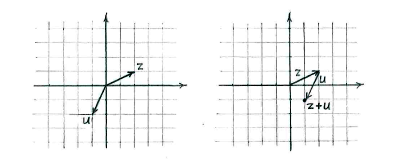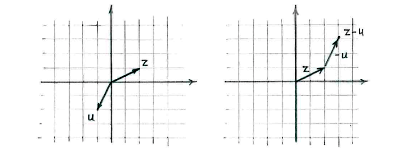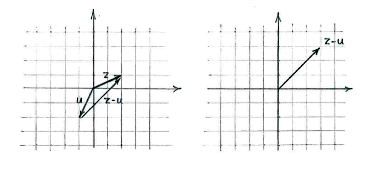Solution 3.2:1b
From Förberedande kurs i matematik 2
(Difference between revisions)
(Ny sida: {{NAVCONTENT_START}} <center> Bild:3_2_1b-1(2).gif </center> {{NAVCONTENT_STOP}} {{NAVCONTENT_START}} <center> Bild:3_2_1b-2(2).gif </center> {{NAVCONTENT_STOP}}) |
m |
||
| (5 intermediate revisions not shown.) | |||
| Line 1: | Line 1: | ||
| - | {{ | + | We can easily calculate <math>z+u</math> and <math>z-u</math>, |
| - | < | + | |
| - | + | {{Displayed math||<math>\begin{align} | |
| - | + | z+u &= 2+i+(-1-2i) = 2-1+(1-2)i = 1-i,\\[5pt] | |
| - | < | + | z-u &= 2+i-(-1-2i) = 2+1+(1+2)i = 3+3i, |
| - | {{ | + | \end{align}</math>}} |
| + | |||
| + | and then mark them on the complex plane. | ||
| + | |||
| + | An alternative is to view <math>z</math> and <math>u</math> as vectors and <math>z+u</math> as a vector addition of <math>z</math> and <math>u</math>. | ||
| + | |||
| + | [[Image:3_2_1_b1.gif|center]] | ||
| + | |||
| + | We can either view the vector subtraction <math>z-u</math> as <math>z+(-u)</math>, | ||
| + | |||
| + | [[Image:3_2_1_b2.gif|center]] | ||
| + | |||
| + | or interpret <math>z-u</math> from the vector relation | ||
| + | |||
| + | {{Displayed math||<math>z=(z-u)+u\,,</math>}} | ||
| + | |||
| + | i.e. <math>z-u</math> is the vector we add to <math>u</math> to arrive at <math>z</math>. | ||
| + | |||
| + | [[Image:3_2_1_b3.gif|center]] | ||
Current revision
We can easily calculate \displaystyle z+u and \displaystyle z-u,
| \displaystyle \begin{align}
z+u &= 2+i+(-1-2i) = 2-1+(1-2)i = 1-i,\\[5pt] z-u &= 2+i-(-1-2i) = 2+1+(1+2)i = 3+3i, \end{align} |
and then mark them on the complex plane.
An alternative is to view \displaystyle z and \displaystyle u as vectors and \displaystyle z+u as a vector addition of \displaystyle z and \displaystyle u.
We can either view the vector subtraction \displaystyle z-u as \displaystyle z+(-u),
or interpret \displaystyle z-u from the vector relation
| \displaystyle z=(z-u)+u\,, |
i.e. \displaystyle z-u is the vector we add to \displaystyle u to arrive at \displaystyle z.



